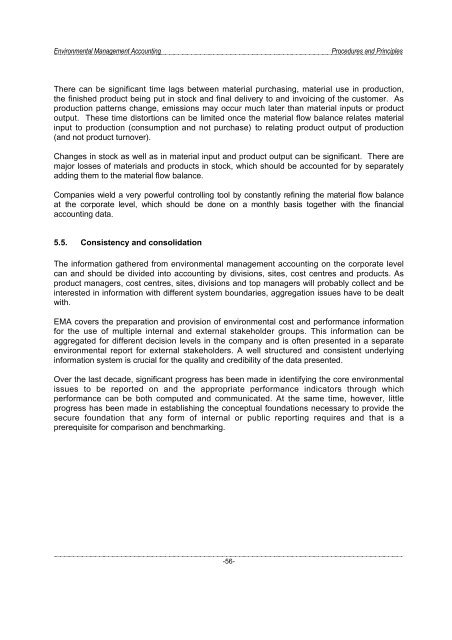Environmental Management Accounting Procedures and Principles
Environmental Management Accounting Procedures and Principles
Environmental Management Accounting Procedures and Principles
Create successful ePaper yourself
Turn your PDF publications into a flip-book with our unique Google optimized e-Paper software.
<strong>Environmental</strong> <strong>Management</strong> <strong>Accounting</strong><br />
<strong>Procedures</strong> <strong>and</strong> <strong>Principles</strong><br />
There can be significant time lags between material purchasing, material use in production,<br />
the finished product being put in stock <strong>and</strong> final delivery to <strong>and</strong> invoicing of the customer. As<br />
production patterns change, emissions may occur much later than material inputs or product<br />
output. These time distortions can be limited once the material flow balance relates material<br />
input to production (consumption <strong>and</strong> not purchase) to relating product output of production<br />
(<strong>and</strong> not product turnover).<br />
Changes in stock as well as in material input <strong>and</strong> product output can be significant. There are<br />
major losses of materials <strong>and</strong> products in stock, which should be accounted for by separately<br />
adding them to the material flow balance.<br />
Compani es wi eld a very powerf ul cont r ol li ng tool by cons tant l y refi ning the mat eri al f low bal ance<br />
at the cor por at e lev el , whi ch should be done on a monthl y bas is together wi th the fi nanci al<br />
acc ount i ng data.<br />
5.5. Consistency <strong>and</strong> consolidation<br />
The information gathered from environmental management accounting on the corporate level<br />
can <strong>and</strong> should be divided into accounting by divisions, sites, cost centres <strong>and</strong> products. As<br />
product managers, cost centres, sites, divisions <strong>and</strong> top managers will probably collect <strong>and</strong> be<br />
interested in information with different system boundaries, aggregation issues have to be dealt<br />
with.<br />
EMA covers the preparation <strong>and</strong> provision of environmental cost <strong>and</strong> performance information<br />
for the use of multiple internal <strong>and</strong> external stakeholder groups. This information can be<br />
aggregated for different decision levels in the company <strong>and</strong> is often presented in a separate<br />
environmental report for external stakeholders. A well structured <strong>and</strong> consistent underlying<br />
information system is crucial for the quality <strong>and</strong> credibility of the data presented.<br />
Over the last decade, significant progress has been made in identifying the core environmental<br />
issues to be reported on <strong>and</strong> the appropriate performance indicators through which<br />
performance can be both computed <strong>and</strong> communicated. At the same time, however, little<br />
progress has been made in establishing the conceptual foundations necessary to provide the<br />
secure foundation that any form of internal or public reporting requires <strong>and</strong> that is a<br />
prerequisite for comparison <strong>and</strong> benchmarking.<br />
-56-




